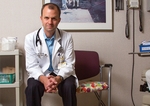business
Mass layoffs continue to hit hospitals hard
■ Health systems say that they are beginning to cut clinical staff as well as administrative workers, but relatively few physicians are losing their jobs.
By Victoria Stagg Elliott — Posted Dec. 16, 2010
- WITH THIS STORY:
- » Related content
The most recent mass-layoff statistics for the hospital industry suggest that 2010 will be a near-record year for job losses from such incidents, according to data released Nov. 23 by the Bureau of Labor Statistics.
Mass layoffs are those affecting at least 50 people working at a single company. Smaller incidents are not counted, but the mass layoff statistics are one marker of the health of this sector of the economy.
In October, 16 mass layoffs occurred involving at least 1,031 people. This is the ninth month of the past 10 that these incidents were in the double digits, and the fourth month that more than 1,000 people lost their jobs.
A total of 128 mass layoffs -- with at least 9,898 people claiming unemployment benefits -- have occurred thus far in 2010. If this pace continues, there will be 154 mass layoffs affecting 11,878 people.
Those figures would top 2009, with its record 152 mass layoffs leading to at least 11,787 lost jobs. In 2005, Hurricane Katrina led to a large number of mass layoffs, with 97 incidents and a record 13,282 claiming unemployment benefits as a result.
BLS numbers for November will be released Dec. 22, and there are signs that these numbers will continue to be high as hospitals respond to cuts in government programs, decreased demand for elective procedures and increased calls for charity care. Layoffs also have extended beyond administrative staff to affect those on the clinical side, although physicians are less commonly included.
The Cleveland Clinic announced Nov. 9 that about 200 employees would lose their jobs. Another 600 vacant positions were eliminated. Jobs cut included clinical and administrative staff, although not physicians. The clinic, in response to changes in demand for services and various economic pressures, scrapped some underused programs and expanded others.
"All hospitals used to be everything to everyone. They did everything," said Eileen Sheil, MPH, Cleveland Clinic spokeswoman. "For strength over the long term and to drive quality outcomes, it makes sense to expand some programs and, in some cases, eliminate a program that is no longer efficient or sustainable."
West Penn Allegheny Health System, based in Pittsburgh, announced Oct. 29 that 400 employees, including some physicians and other clinical staff, would be laid off by the end of the year.
"It's pretty much across the board -- administrative positions, technicians, physicians, nurses," said Dan Laurent, the system's director of media relations.
The system had announced in June that about 1,500 layoffs would result from the consolidation of Allegheny General Hospital and Western Pennsylvania Hospital. But this number was reduced, because some employees accepted other open positions within the system. Others resigned.
"We have done everything possible to minimize the number of people who will lose jobs as a result of our changes," said Christopher T. Olivia, MD, president and CEO of the health system.












